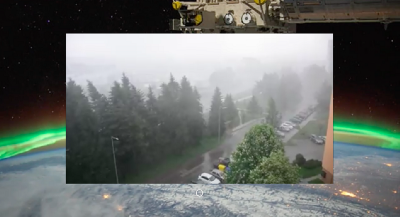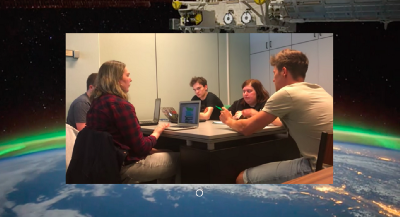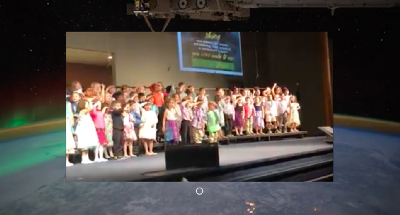- “The purpose of visualization is insight, not pictures.” — Manuel Lima, quoting computer scientist Ben Schneiderman
- “Data visualization is not your creative outlet; data visualization is making data understandable.” — OpenVizConf
- “[Before the Data Viz Project] there [was] no one place to go, where there are the correct answers for how the data visualizations work.” — Jeppe
- “Yes, you can design a chart. Yes, you can add a pretty illustration. But this is not what true data visualization is. The entire point of the art is to make data as comprehensible as possible, to present it in the most easy-to-digest format.” — Column Five Media
I think we can do better than this. A lot better. I think we have to.
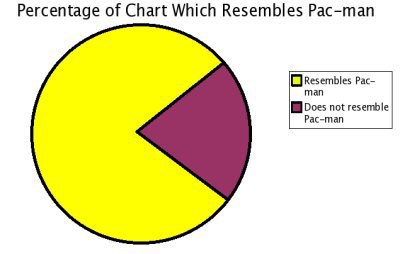
I see two assumptions often baked into how people talk about dataviz. I think they’re worth talking about about explicitly when trying to understand what this medium is and what it can do. These assumptions are:
- Dataviz is a sub-genre of computer science, or engineering.
- Dataviz is “for” a particular thing, and there are right and wrong ways to do it.
It’s past time for those of us who do this work to realize that telling stories with data is not a sub-genre of computer science, or of anything else for that matter. Dataviz is dataviz. It’s not a sub-genre of anything, any more than movies are a sub-genre of live theater, or photography is a sub-genre of painting. Computer science has about as much to say about the medium of data visualization as photographic paper engineering has to say about Instagram. Computer science can be the technical underpinnings of dataviz, sometimes. Dataviz is the medium.
Dataviz! Data visualization! I don’t think it’s for anything! I don’t believe it’s meaningful to say that dataviz is for one thing, any more than it’s meaningful to say that architecture is for any one thing. Or that photography is for one thing, that it has a purpose that can be defined in a sentence or two. Or that movies are for one thing, one that you could win an argument about.
What are movies for? What is photography for? What is dataviz for?
I suppose you could argue what movies are for, what the purpose of them is, what a proper or effective movie is. You could say that documentaries are movies, and Andy Warhol’s 24 hour long film of the Empire State Building is a movie, but the raw (and generally unwatched by anyone at all on YouTube, which is a pretty interesting source of material if you think about it) video clips that Andrew Wong stitches together into the brilliant astronaut.io are not. How would you win such an argument? And who would care about the outcome, beyond the tiniest circle of initiates?
If we’re going to say, as Martin Wattenberg and Fernanda Viegas do, that dataviz is going mainstream, then it’s time to unequivocally say that dataviz doesn’t belong exclusively or even mainly in the Human Computer Interaction Lab, or in any other lab. It’s its own field of endeavor. It’s as rich in nuance, as embedded in history, and as compromised by bias as science, journalism or filmmaking. It’s time to start talking about it this way.
It’s sometimes easier to start by talking about maps. Humans have been making them forever, and everyone knows what they are. Cartography is a much better place to situate the roots of this medium and discipline than computer science is, to pick one alternative. This is why at Stamen we’ve continued to make more traditional maps as well as what people are calling data visualizations, and we’ve never seen much value in drawing bright lines between the two. I’ve heard our friends and clients at Tableau describe maps as scatterplots with very particular axis definitions, latitude and longitude. A map is just a dataviz with latitudes and longitudes attached. Mapping and dataviz are not separate disciplines.
“The purpose of movies is insight, not pictures.” What a boring thing to say! That may be true of a how-to video on YouTube, but there’d be no Hollywood if we all thought this way. No Bollywood, no Netflix. The late great Hans Rosling was a master at making movies about dataviz which were richly complex and highly entertaining. These films are about as far from being in the most easy-to-digest format as they could be. They require a trained narrator and sword swallower to explain what’s happening!
The idea that dataviz has a purpose that can be articulated in a sentence feels needlessly reductionist. Here’s a good rule of thumb: if you can’t say it about movies, or photography, you probably shouldn’t say it about dataviz.
I think that “boring” is an important word to use when having these discussions. There are as many reasons to make movies as there are stories to tell. And there are really boring ways to talk about movies, but also really exciting ways to talk about movies. I’m much more interested in talking about what movies can do than I am in arguing about what they’re for.
Part of what movies are “for,” a huge part of the practice of making movies from my point of view, is all about is finding new kinds of movies to make. What is the new Blade Runner trailer “for”? It’s to knock on the sky and freak us all out and generate amazing press. “The purpose of movies is to enlighten and inform, not to distract.” Nuts. Tell that to Kathryn Bigelow. Tell that to Ridley Scott. Or Ken Burns. Or Charles and Ray Eames. Or to Andrew Wong. Gah!
I’m in London, where a piece the Victoria and Albert commissioned from Stamen, Big Glass Mic, is being shown in their The Future Starts Here show, opening on May 12. The work is about the visualization of perturbations in a five kilometer long fiber optic cable buried under Stanford University. Using software from Optasense, the researchers at the Stanford Exploration Project and Stanford’s School of Earth, Energy & Environmental Sciences are using the data in the cable doing amazing work analyzing seismic activity around the San Andreas Fault. We used it to make art for a museum show, to start a conversation about the increasingly pervasive and unseen nature of infrastructure, to discover cars and bikes driving around, to have some fun.
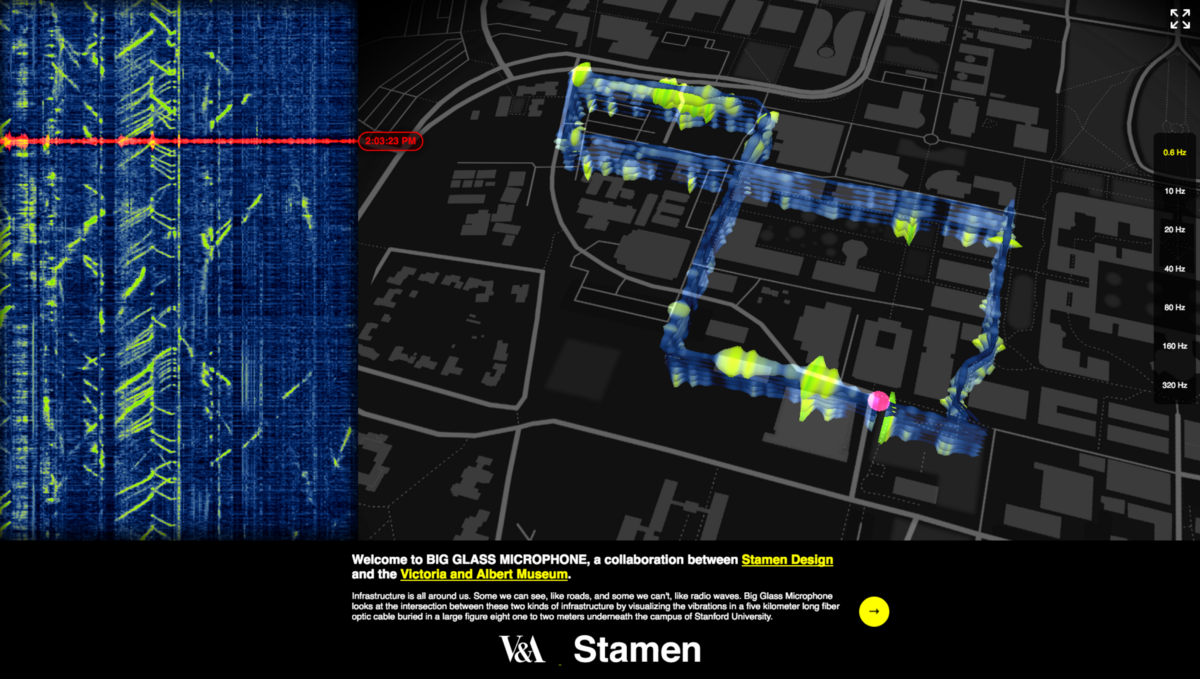
To return to the statements this post opens with: does it value insight over pictures? Probably not. Is it a creative outlet? You bet it is. Is it correct? Who cares? Is this the easiest-to-understand way to depict this data? Arguable.
Is it data visualization? I’m pretty sure it is. I’d be curious to talk with anyone who disagrees.
This very particular way of talking about dataviz, where different people argue about what it’s for, and expect to be correct, is a particular hallmark of an immaturity of thinking around a medium. It presumes that this is a question that could really ever be settled by any one faction. It also belies a lack of appreciation for the expressive potential of that medium.
I don’t think this will change until words like “cinema” get replaced by words like “movie.” I’ve deliberately used “dataviz” throughout this, even though it’s awkward. Dumbing down the words that are used to describe a medium is a crucial step in making the medium a mainstream concern. No one says “cinema” anymore outside of the academy, and that’s a good thing. We all say “movie,” or “trailer,” or “Netflix and chill.” Until we find a better word for this medium than “data visualization,” we’re going to keep thinking of ourselves as practitioners. And that’s a very, very small subset of who we are.
I don’t know what the word is yet. I bet I’ll know it when I see it. Maybe it’s “making maps.” When people ask me what I do these days, I don’t start with a long discussion of data and visuals and storytelling and technology. I tell them “I make maps.” It’s so much simpler.
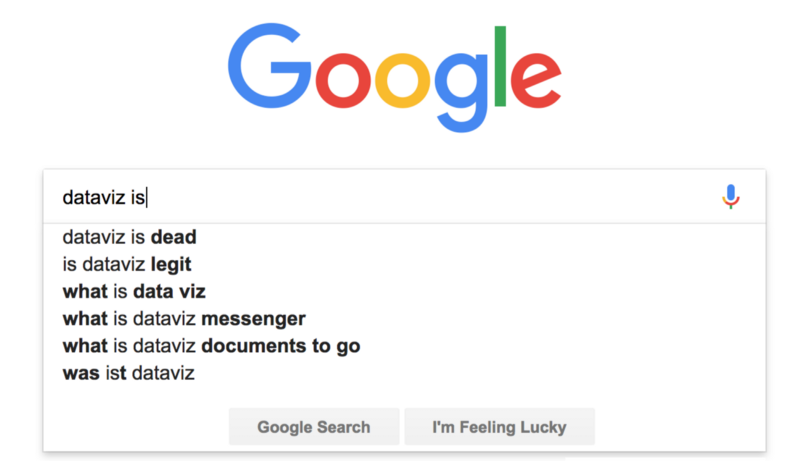
I believe this: “In a post-truth world, data and facts are important, but so are stories, empathy, and passion because data and facts are not enough. Data visualization can no longer be isolated in a niche of its own. It is increasingly at the center of meaning-making and storytelling.”—Jon Christensen
Arguing as though you can be right about what a field of activity is for is a pretty good indication that it’s niche, or at least that the way you’re thinking about it is niche. Dataviz is not niche! We have to stop talking about it as though it were something that a few of us get to decide what it is!
I don’t mean to say that arguing about it doesn’t matter. We should argue about dataviz just as much as, and in the same vein as, film students who pore over every frame of early Kubrick films, as Star Trek fans who dress up as their favorite characters at Comic Con, literature critics who can’t agree on whether Watchmen is better than Sandman, about the connections between James Joyce and fiber optic cables buried under the ground at Stanford. It’s just that argument, on its own, isn’t enough. And pretending that it can be diminishes this medium’s potential and its power.
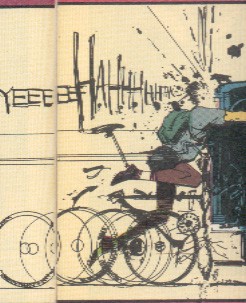
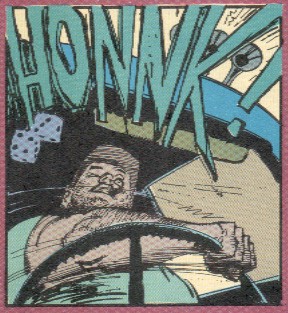
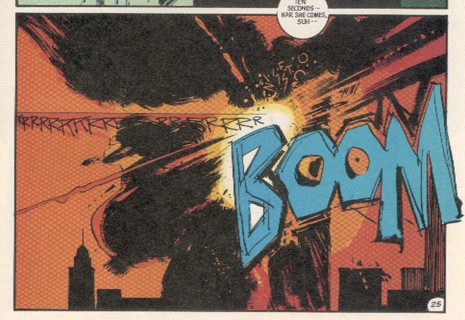
“Correct” means there’s a right way to do things. No one would say there’s a correct way to paint, draw, sing. You might say there’s a correct way to do journalism, but this is typically expressed more as being about best practices and having integrity than about any particular writing style or even accessibility. There are lots of different forms of journalism, and no one conflates the work of Walter Cronkite with that of Hunter S. Thompson, or says that one of them did it correctly and the other did it improperly (at least not any more). We have to get past this idea that there is a correct way to do data visualization!

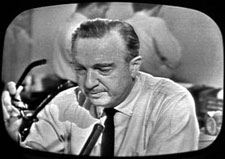
Data visualization has to pull off the same paradoxical split as photography and the movies (and, not for nothing, comic books) did. Get more highbrow: being part of the larger discourse and rough and tumble world of media and critique, not just fellow “practitioners.” And lowbrow: recognizing that it can be used to lie and tell jokes and that these uses of the medium are just as legitimate as is the pursuit of an unvarnished truth and insight.
Until we do this, we’ll be stuck in boring debates about what it’s for and who’s in and who’s out. Within this framework our medium will never achieve its true potential. And the full scope of that potential, which is as vast and rich as that of movies and photography, is only just now becoming clear.

